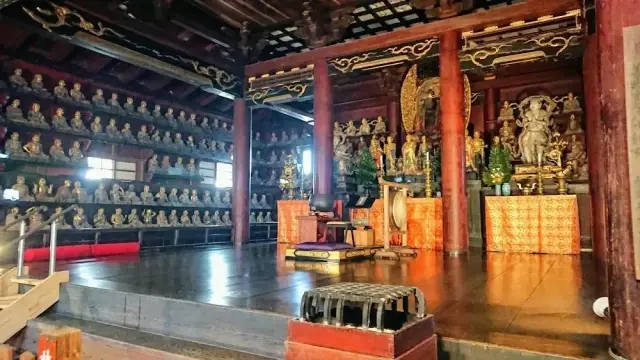https://www.dekitabi.com/itinerary/morioka-essential-day-tour
Morioka, with its rich blend of historical sites, cultural landmarks, and serene natural beauty, offers a captivating experience for travelers. From the evocative ruins of Morioka Castle Park to the spiritual tranquility of Sakurayama Shrine and Hoonji Temple, each location provides a unique insight into the city’s heritage. The Morioka History and Culture Museum and the Iwate Bank Red Brick Building further enrich your understanding of Morioka’s past.
Whether you’re a history buff, a culture enthusiast, or simply seeking a peaceful retreat, Morioka’s diverse attractions promise a memorable journey through Japan’s fascinating past and vibrant present.
Morioka Castle Ruins Park: A Historic Gem

https://www.dekitabi.com/attraction/moriokajo-castle-site-park
Nestled in the heart of Morioka, Morioka Castle Ruins Park is a must-visit destination for history enthusiasts and nature lovers alike. The park, located on the site of the former Morioka Castle, offers a serene escape while providing a glimpse into Japan’s rich past.
The castle was originally constructed in the late 16th century during the Edo period. Today, while the castle structure itself is no longer standing, visitors can explore the extensive stone foundations and reconstructed gates that hint at the castle’s former grandeur. The park is particularly famous for its cherry blossoms in spring, which transform the area into a picturesque landscape of pink and white blooms.
Strolling through Morioka Castle Ruins Park, you’ll find well-maintained walking paths that wind through lush gardens and historic ruins. The elevated vantage points offer panoramic views of the city and surrounding mountains, making it an ideal spot for photography and leisurely walks.
Sakurayama Shrine: A Spiritual Retreat

https://www.dekitabi.com/attraction/sakurayama-shrine-morioka
Just a short walk from Morioka Castle Ruins Park, Sakurayama Shrine is a spiritual haven with deep cultural significance. This Shinto shrine is dedicated to the deity of fertility and protection. Established in the early 17th century, Sakurayama Shrine is renowned for its beautiful architecture and tranquil setting.
The shrine’s grounds are adorned with traditional Japanese lanterns, intricate wooden carvings, and a serene koi pond. Visitors can participate in age-old Shinto rituals, such as making wishes and offering prayers. The annual festivals held at Sakurayama Shrine attract locals and tourists alike, providing a vibrant experience of Japanese culture and traditions.
Morioka History and Culture Museum: A Journey Through Time

https://www.dekitabi.com/attraction/morioka-history-and-culture-museum
For those eager to delve deeper into Morioka’s heritage, the Morioka History and Culture Museum offers an immersive experience. This museum showcases the rich tapestry of Morioka’s past, from ancient times to the modern era.
The exhibits include a diverse collection of artifacts, including traditional clothing, ancient tools, and artworks that illustrate the daily life and cultural practices of historical Morioka. Interactive displays and informative panels provide visitors with engaging insights into the region’s history. The museum’s architecture itself is a blend of traditional and contemporary styles, creating a unique backdrop for exploring Morioka’s heritage.
Iwate Bank Red Brick Building: A Historical Landmark

https://www.dekitabi.com/attraction/bank-of-iwate-red-brick
The Iwate Bank Red Brick Building stands as a striking example of late 19th-century Western architecture in Japan. Located in the center of Morioka, this historic building was constructed in 1911 and functioned as a bank until the 1960s. Its red brick facade and elegant design make it a notable landmark in the city.
Today, the building houses the Iwate Bank’s museum and various exhibitions that highlight the region’s economic history. The building’s restored interiors offer a glimpse into the past, showcasing period furnishings and banking equipment. The Iwate Bank Red Brick Building is not only a testament to Morioka’s architectural heritage but also a symbol of the city’s historical development.
Hoonji Temple: A Peaceful Sanctuary

https://www.dekitabi.com/attraction/hoonji-temple-morioka
Hoonji Temple, located a short distance from Morioka’s city center, is a serene Buddhist temple known for its tranquil atmosphere and historical significance. Founded in the 16th century, Hoonji Temple is part of the Soto school of Zen Buddhism.
The temple’s grounds are beautifully landscaped with traditional Japanese gardens, including carefully raked gravel and meticulously trimmed bonsai trees. Visitors can explore the main hall, where intricate wood carvings and serene Buddhist statues create a contemplative environment. The temple also offers meditation sessions and tea ceremonies, providing an opportunity for visitors to experience Zen practices firsthand.
Morioka Hachimangu Shrine: A Cultural Icon

https://www.dekitabi.com/attraction/morioka-hachimangu
Morioka Hachimangu Shrine, dedicated to the Shinto deity Hachiman, is a cultural icon of the city. Established in the 9th century, this shrine is one of the oldest and most revered Shinto sites in the region. Its historic significance and stunning architecture make it a focal point for both locals and visitors.
The shrine’s main hall features traditional Japanese architectural elements, including a thatched roof and elaborate wooden carvings. The grounds are home to several smaller shrines, each dedicated to different deities. Morioka Hachimangu Shrine is known for its vibrant festivals, particularly the annual Morioka Sansa Odori, a traditional dance festival that attracts thousands of participants and spectators.


Leave a Reply